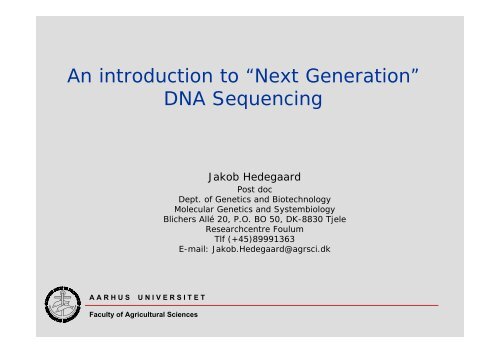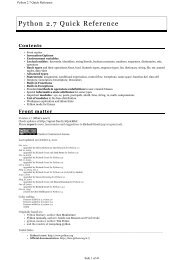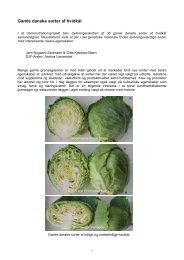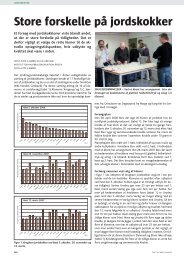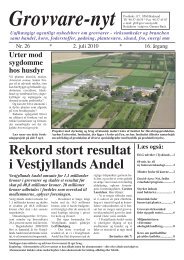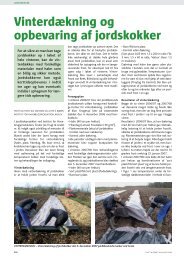Module 6 NGS intro
Module 6 NGS intro
Module 6 NGS intro
Create successful ePaper yourself
Turn your PDF publications into a flip-book with our unique Google optimized e-Paper software.
An <strong>intro</strong>duction to “Next Generation”<br />
DNA Sequencing<br />
A A R H U S U N I V E R S I T E T<br />
Faculty of Agricultural Sciences<br />
Jakob Hedegaard<br />
Post doc<br />
Dept. of Genetics and Biotechnology<br />
Molecular Genetics and Systembiology<br />
Blichers Allé 20, P.O. BO 50, DK-8830 Tjele<br />
Researchcentre Foulum<br />
Tlf (+45)89991363<br />
E-mail: Jakob.Hedegaard@agrsci.dk
Programme<br />
Monday <strong>NGS</strong> <strong>intro</strong><br />
(RNA to sequences)<br />
Tuesday<br />
Wednesday <strong>NGS</strong>, pre-processing<br />
(Sequences to counts)<br />
RNA- seq analysis<br />
(Counts to list(s))<br />
Thursday Sequence based analysis Supervised and unsupervised<br />
learning<br />
Friday Gene set analysis<br />
a.m. p.m.
RNA to sequences<br />
The aims of today are to understand (or get an idea about):<br />
• the potential use of <strong>NGS</strong> technology<br />
• the basic principles of the Illumina technology<br />
• the sample prep methods for mRNA-Seq (and RNA-Seq)<br />
• the options for experimental design for mRNA-Seq<br />
• the basic principles of processing the raw data from an Illumina GA<br />
• the output and format of the data produced by an Illumina GA<br />
Case study<br />
Software check<br />
Questions and breaks!
DNA Sequencing technology<br />
Pharmacia ALF DNA Sequencer<br />
Sanger method (chain-terminator method)<br />
- Fluorescent labeled primer<br />
- 4 reactions/sample<br />
- 10 sequences of 3-500 bp<br />
- sequence preparation and ON run
Short history of DNA Sequencing<br />
1977<br />
– Maxim-Gilbert<br />
–Sanger<br />
1986<br />
– First Automated DNA<br />
Sequencer ABI 370 (373)<br />
1988<br />
–Pharmacia ALF<br />
1995<br />
–ABI 377<br />
Up to 96 lanes<br />
1996<br />
– First Capillary DNA<br />
Sequencer ABI 310<br />
1998<br />
– First 96 Capillary instruments<br />
MegaBace, ABI 3700<br />
2000<br />
– ABI 3100, 16 Capillary<br />
2002<br />
– ABI 3730, 48 or 96 Capillary<br />
2005<br />
– Genome Sequencer GS20 (454)<br />
2006<br />
– Solexa (Illumina)<br />
2007<br />
–SOLiD<br />
2011<br />
–?
Short history of DNA Sequencing<br />
Method Read<br />
length<br />
(max bp)<br />
Dye-<br />
Terminator<br />
(3730xl)<br />
454/Roche<br />
(GS FLX)<br />
Illumina<br />
(GA)<br />
Illumina<br />
(HiSeq)<br />
Applied<br />
(SOLiD)<br />
Sequences<br />
per run<br />
Run time Output/<br />
day<br />
Output/<br />
run<br />
1,500 96 1 hr ~1-2 Mbp ~70 Kbp<br />
400 ~ 1 million 10 hrs ~1 Gbp ~400 Mbp<br />
150 ~300<br />
millions<br />
14 days<br />
(2x150 bp)<br />
100 ~1 billion 8 days<br />
(2x100 bp)<br />
75 ~2.8 billions 7 days<br />
(60x60 pb)<br />
~7 Gbp ~90 Gbp<br />
~25 Gbp ~200 Gbp<br />
~25 Gbp ~200 Gbp
<strong>NGS</strong> – also known as…<br />
• Next generation sequencing (<strong>NGS</strong>)<br />
• High-throughput sequencing (HTS or HT-Seq)<br />
• Flow cell sequencing (FCS)<br />
• Massively parallel sequencing (MPS)<br />
• Deep sequencing<br />
• Many other synonyms!
Applied Biosystems<br />
5500xl SOLiD<br />
Illumina<br />
HiSeq 2000<br />
<strong>NGS</strong> technologies<br />
Roche/454<br />
Genome Sequencer FLX<br />
Illumina<br />
Genome Analyser IIx<br />
Additional technologies – and more to come!
Illumina Sequencing technology<br />
Applications<br />
Whole genome<br />
Targeted genome<br />
Long PCR<br />
Pull-down<br />
Epigenome<br />
Bisulfite<br />
Restriction<br />
Restriction +<br />
bisulfite<br />
Antibody pulldown<br />
Ab. + bisulfite<br />
Whole transcriptome<br />
All RNA<br />
RNA minus rRNA,<br />
tRNA<br />
PolyA<br />
ncRNA<br />
Gene expression (DGE)<br />
Small RNA<br />
RISC RNA products<br />
Protein:DNA<br />
Protein:RNA<br />
Library Generation<br />
(hours-days)<br />
DNA Fragments<br />
~200 bp<br />
+<br />
Adapters<br />
Cluster Generation<br />
(~5 hours)<br />
Sequencing<br />
(days, 1.1 hrs/cycle)
Illumina Sequencing Technology<br />
Reversible Terminator Chemistry<br />
DNA<br />
(0.1-1.0 ug)<br />
Sample<br />
preparation<br />
Single molecule array<br />
Cluster growth 5’<br />
1 2 3 4 5 6 7 8 9<br />
Image acquisition<br />
A<br />
C<br />
T<br />
C<br />
T<br />
G<br />
C<br />
T<br />
G<br />
A<br />
A<br />
G<br />
Sequencing<br />
Base calling<br />
3’<br />
5’<br />
T<br />
G<br />
C<br />
T<br />
A<br />
C<br />
G<br />
A<br />
T<br />
A<br />
C<br />
C<br />
C<br />
G<br />
A<br />
T<br />
C<br />
G<br />
A<br />
T<br />
T G C T A C G A T …
Illumina Sequencing Technology<br />
Flow cell<br />
A flow cell contains eight<br />
lanes<br />
Each lane contains two columns of tiles<br />
Lane 1<br />
Lane 2<br />
.<br />
.<br />
.<br />
Lane 8<br />
Each column contains multiple tiles –total 120<br />
Each tile is imaged four times per cycle –<br />
one image per base.<br />
~340.000 clusters/tile -><br />
~40.000.000 clusters/lane -><br />
~320.000.000 clusters/flowcell<br />
Column 1<br />
Column 2
Illumina GA output
Illumina GA Sequencing technology<br />
Pipeline Computer<br />
”Donkey”<br />
DELL PowerEdge 2900<br />
8 cores (2 x 4 CPU, 2.6 GHz)<br />
16 GB RAM<br />
4.7 TB hard drive<br />
Switch<br />
100 Mbps<br />
• Storage<br />
• Analysis<br />
GAIIx, “Oban” Cluster Station GAIIx, “Lagavulin”
Illumina GA Sequencing technology<br />
Switch and 100<br />
Mbps network<br />
to pipeline<br />
computer<br />
Paired End<br />
(PE) module<br />
GA PC<br />
•2.66 GHz cpu<br />
•3 GB RAM<br />
•80 GB hard drive<br />
Illumina Genome Analyzer IIx, “Oban”<br />
Cooling unit!<br />
Genome Analyzer<br />
(GAIIx)<br />
Uninterruptible Power<br />
Supply (UPS)<br />
•Back up for ~10 min
Illumina GA Sequencing technology<br />
Pielter<br />
element<br />
Liquid outlet<br />
Liquid inlet<br />
Flowcell<br />
& Prism<br />
Camera<br />
Laser
Illumina Sequencing technology<br />
Single-end<br />
Paired-end<br />
Multiplex<br />
1.<br />
1.<br />
2.<br />
(3.)<br />
2.
Illumina Sequencing technology<br />
Single End Paired End
Illumina Sequencing technology<br />
Mate Pair
SR and PE flowcells
Single-Read flowcells
Single-Read flowcells
Single-Read flowcells
Single-Read flowcells<br />
Cluster Station<br />
GAII, “Oban”<br />
Amplification<br />
Linearization<br />
Blocking<br />
Primer hybridization<br />
Sequencing – single read
Paired-End flowcells
Paired-End flowcells
Paired-End flowcells
Paired-End flowcells
Paired-End flowcells<br />
Cluster Station<br />
GAII, “Oban”<br />
Amplification<br />
Linearization<br />
Blocking<br />
Primer hybridization<br />
Sequencing – read 1<br />
Denaturation +<br />
de-protection<br />
Re-synthesis<br />
Linearization<br />
Sequencing – read 2<br />
Primer hybridization<br />
Blocking
Using <strong>NGS</strong> for expression profiling:<br />
mRNA-Seq<br />
Digital gene expression<br />
• Sequencing of tags<br />
• Mapping tags to transcriptome -> counts<br />
• Counts, 0 - ∞<br />
• All genes/transcripts<br />
• Added information<br />
(Alternative transcripts, SNPs, novel genes,…)
RNA<br />
RNA-Seq – library preparation<br />
Coding<br />
Non-coding<br />
PolyA<br />
mRNA<br />
Non-PolyA<br />
mRNA<br />
Structural RNA<br />
associated<br />
Regulatory<br />
DNA<br />
associated<br />
Ribosome<br />
associated<br />
MicroRNA<br />
Transcriptional<br />
start site<br />
associated<br />
Anti-sense<br />
Enhancer<br />
RNA<br />
Replisome<br />
DNA Repair<br />
Telomeric<br />
DNA<br />
methylation<br />
rRNA
mRNA-Seq – library preparation<br />
Total RNA (10 µg)<br />
Purify and fragment mRNA<br />
ds cDNA synthesis (random primed)<br />
Repair ends<br />
Add ‘A’ bases to 3’ ends<br />
Ligate adapters<br />
Purify ligation product (200-500 bp)<br />
PCR amplification
RNA – library preparations<br />
mRNA-Seq<br />
Purified Total RNA<br />
Poly-A Selection<br />
RNA Fragmentation<br />
cDNA Synthesis<br />
Adapter Ligation<br />
PCR<br />
TotalRNA-Seq I<br />
Purified Total RNA<br />
RNA Fragmentation<br />
cDNA Synthesis<br />
Adapter Ligation<br />
PCR<br />
Normalization<br />
e.g. DSN to remove<br />
very abundant elements<br />
TotalRNA-Seq II<br />
Purified Total RNA<br />
Removal of rRNA<br />
RNA Fragmentation<br />
cDNA Synthesis<br />
Adapter Ligation<br />
PCR
RNA – library preparations<br />
smallRNA-Seq<br />
Purified Total RNA<br />
PAGE Selection<br />
RNA Adapter Ligation<br />
1. strand cDNA Synthesis<br />
PCR<br />
PAGE Selection<br />
Directional mRNA-Seq<br />
Purified Total RNA<br />
Poly-A Selection<br />
RNA Fragmentation<br />
RNA Adapter Ligation<br />
1. strand cDNA Synthesis<br />
PCR
RNA – library preparations<br />
More variations:<br />
• Multiplexing/indexing (more than 1 sample/lane)<br />
• PCR free protocols<br />
• Robot compatible protocols<br />
• Tagged RT primer + terminal tagged oligo + index-PCR (Epicentre)<br />
• Amplification based methods for samples with limited RNA<br />
• …… more to come!<br />
Confused?
mRNA-Seq – library preparation<br />
Total RNA (10 µg)<br />
Purify and fragment mRNA<br />
ds cDNA synthesis (random primed)<br />
Repair ends<br />
Add ‘A’ bases to 3’ ends<br />
Ligate adapters<br />
Purify ligation product (200-500 bp)<br />
PCR amplification
Illumina - multiplex
Intensity versus Cycle<br />
genomic DNA<br />
mRNA (RNA-Seq)<br />
”random” priming?<br />
Hansen et al, Nucl. Acids Res. (2010) 38 (12): e131.<br />
small-RNA
• Hybridization to probes<br />
• Intensities, 0 – N (analog)<br />
• Fixed gene-set<br />
• Proven technology<br />
• Costs ?<br />
• ……<br />
Array vs <strong>NGS</strong><br />
• Sequencing of tags<br />
• Counts, 0 - ∞ (digital)<br />
• All genes/transcripts<br />
• Added information<br />
• Costs ?<br />
• ……
Array vs <strong>NGS</strong><br />
mRNA-Seq data is information rich<br />
• mRNA Expression Profiling<br />
• Alternative Splicing Analysis<br />
• Analysis of expressed SNPs and mutations<br />
• Analysis of Allelic-specific Expression<br />
• Chimeric Transcript Discovery<br />
• Gene Discovery and Annotation<br />
• ……<br />
(<strong>Module</strong> 11, Thursday: Sequence based analysis)
Array vs <strong>NGS</strong><br />
As in the early days of microarray technology….<br />
• The <strong>NGS</strong> technology is still under development<br />
• The library prep methods (technology, biases, robot assisted, ……)<br />
• Development of analytical tools and methods<br />
• Education and training to handle the data<br />
•……
Experimental design (mRNA-Seq)<br />
Objective(s) of the study -> number of reads needed/sample<br />
Counting/profiling 5-10 million reads/sample<br />
Alternative splicing 50-100 million reads/sample<br />
Novel discovery >100 million reads/sample<br />
Multiplexing?<br />
- Illumina GAIIx: 35-40 million reads/lane<br />
- Done after 1 lane? repeat in several lanes/flowcells(runs)?<br />
Replication?<br />
- Biological vs. technical<br />
Batch effects<br />
- RNA purification<br />
- library preparation (and method)<br />
- flowcell/sequencing run<br />
- chemistry batches<br />
-?
Experimental design (mRNA-Seq)<br />
• Replication<br />
• Randomization<br />
• Blocking<br />
!<br />
Genetics 185: 405–416 ( June 2010)
Data processing
Data processing<br />
Illumina software<br />
Alternative software
1<br />
2<br />
Analysis<br />
GA-PC (SCS software, RTA)<br />
• image analysis<br />
• base calling<br />
Pipeline Computer, ”Donkey”<br />
• sequence analysis<br />
alignment to reference<br />
produces fastq files
Data - structure<br />
Real Time Analysis (RTA) output
BCL Converter output<br />
Data - structure<br />
Disk space use<br />
• Depends on the run (SE,PE, #sequences)<br />
• Images are deleted<br />
• Complete run folder ~ 1-2 TB (no images!)<br />
• Minimum data set ~ 20-40 GB<br />
• More space needed for analyzing the data!
Data, the qseq files<br />
1 x _qseq.txt file/tile/lane -><br />
• single-end: 960 _qseq.txt files (120x8)<br />
• paired-end: 1,920 _qseq.txt files (120x8x2)<br />
• paired-end, multiplex: 2,880 _qseq.txt files (120x8x3)<br />
……………………<br />
……………………<br />
O 11 1 20 18235 1120 0 1 GGCGGCGGGC....GAGGGGGGGG BBBBBBBBBB....BBBBBBBBBB 0<br />
O 11 1 20 18284 1125 0 1 ATGCCACCGC....ATGAAGAATA BBBBBBBBBB....BBBBBBBBBB 0<br />
O 11 1 20 18449 1128 0 1 ACTTGAAATA....ATTTGGATAT `BBBBBBBBB....BBBBBBBBBB 0<br />
O 11 1 20 18499 1123 0 1 CTTATTCAGG....GTGATTGAAG `][XUYKOMM....BBBBBBBBBB 0<br />
O 11 1 20 18546 1128 0 1 CGCATATCGT....TGAGCATGAA e_cS]becbe....BBBBBBBBBB 1<br />
O 11 1 20 18607 1120 0 1 CCCATTCGCA....TAATGTGATC SRSRQ[QW\\....BBBBBBBBBB 1<br />
O 11 1 20 18669 1125 0 1 CTTTTACGCA....AGACTGGAAA c_Scca[]cc....BBBBBBBBBB 1<br />
O 11 1 20 18783 1121 0 1 CCGGTGTGAT....AGTTAATGGA ccccR`Za`a....^^ZYb^]Hb^ 1<br />
……………………<br />
……………………<br />
A B C D<br />
A<br />
B<br />
C<br />
D<br />
Read number (1 or 2 for paired end runs; 1,2 or 3 for indexed paired-end)<br />
Sequence<br />
Quality string<br />
Filtering (1 for pass and 0 for failed)
Data, the fastq files<br />
Conversion of qseq -> fastq<br />
1 x fastq file/lane/read -><br />
• single-end: 8 x fastq files (s_4_sequence.txt)<br />
• paired-end: 16x fastq files(s_4_1_sequence.txt, s_4_2_sequence.txt)<br />
• paired-end, multiplex: as paired-end (index included in fastq)<br />
Fastq: same information as in qseq files, but<br />
• different format<br />
• 4 lines/sequence -> .txt files with 4x~40 millions lines<br />
• only sequences passing the signal purity filter<br />
Pass: the second lowest chastity score in the first 25 cycles of a read<br />
must be greater than 0.6<br />
Chastity is the ratio of the highest of the four (base type) intensities<br />
to the sum of highest two<br />
Further quality (phred) based filtration can be applied on the fastq files
Fastq file<br />
qseq file<br />
Data, the fastq files<br />
……………<br />
……………<br />
@L_0023:1:1:16103:1200#0/1<br />
TTATGTGTTTATTACGTTNTTTG……AATGTTTATTTACGGGTTATTTA<br />
+L_0023:1:1:16103:1200#0/1<br />
hhhhhhghhhhhhghdeeBee__…… hfhhghhghhghfffaehghhcX<br />
@L_0023:1:1:16318:1210#0/1<br />
TGTGAAAGAATTGTTAGTTGGGA…… TTAGGTGTTTATATGTTTAAATT<br />
+L_0023:1:1:16318:1210#0/1<br />
Y_fXfdfafc`a_g_g_gdd\af…… ffddfcffffffgggggfffcff<br />
……………<br />
……………<br />
Header<br />
Sequence<br />
Header<br />
Quality string<br />
……………………<br />
……………………<br />
O 11 1 20 18235 1120 0 1 GGCGGCGGGC....GAGGGGGGGG BBBBBBBBBB....BBBBBBBBBB 0<br />
O 11 1 20 18284 1125 0 1 ATGCCACCGC....ATGAAGAATA BBBBBBBBBB....BBBBBBBBBB 0<br />
O 11 1 20 18449 1128 0 1 ACTTGAAATA....ATTTGGATAT `BBBBBBBBB....BBBBBBBBBB 0<br />
O 11 1 20 18499 1123 0 1 CTTATTCAGG....GTGATTGAAG `][XUYKOMM....BBBBBBBBBB 0<br />
O 11 1 20 18546 1128 0 1 CGCATATCGT....TGAGCATGAA e_cS]becbe....BBBBBBBBBB 1<br />
O 11 1 20 18607 1120 0 1 CCCATTCGCA....TAATGTGATC SRSRQ[QW\\....BBBBBBBBBB 1<br />
O 11 1 20 18669 1125 0 1 CTTTTACGCA....AGACTGGAAA c_Scca[]cc....BBBBBBBBBB 1<br />
O 11 1 20 18783 1121 0 1 CCGGTGTGAT....AGTTAATGGA ccccR`Za`a....^^ZYb^]Hb^ 1<br />
……………………<br />
……………………
Data, the fastq files<br />
……………<br />
……………<br />
@L_0023:1:1:16103:1200#0/1<br />
TTATGTGTTTATTACGTTNTTTG……AATGTTTATTTACGGGTTATTTA<br />
+L_0023:1:1:16103:1200#0/1<br />
hhhhhhghhhhhhghdeeBee__…… hfhhghhghhghfffaehghhcX<br />
@L_0023:1:1:16318:1210#0/1<br />
TGTGAAAGAATTGTTAGTTGGGA…… TTAGGTGTTTATATGTTTAAATT<br />
+L_0023:1:1:16318:1210#0/1<br />
Y_fXfdfafc`a_g_g_gdd\af…… ffddfcffffffgggggfffcff<br />
……………<br />
……………<br />
……………<br />
……………<br />
@L_0017:1:1:7461:1105#CGATGT/1<br />
GGGTGATCATTTAATATTNCCGCCGTGCAGGGTAGCTAATCAACTAAATA<br />
+L_0017:1:1:7461:1105#CGATGT/1<br />
cdddaa^c[addcdda\`Bba^aZ\Z`UR_a^K[\c^a]Lddb]Wad`\]<br />
@L_0017:1:1:15703:1104#CGATGT/1<br />
CTGCTTTCAGATGCTGTCNTTTTATTAGTGAGTGATGATGGTTTGCTAAT<br />
+L_0017:1:1:15703:1104#CGATGT/1<br />
hhfhhhhhhhhhfhhdbbBbffdb`h_cecf_bacdeedegfffdcaca]<br />
……………<br />
……………<br />
Fastq file<br />
Fastq file from indexed run
Data, the fastq files<br />
The Illumina fastq header - sequence<br />
Paired-end read:<br />
@L_0020:4:4:4:1052#0/1<br />
@L_0020:4:4:4:1052#0/2<br />
Indexed read:<br />
@L_0001:3:1:4:1303#GATCAG/1<br />
L_0001 unique instrument name and run number<br />
3 flowcell lane (1-8)<br />
1 tile number within the flowcell lane (1-120)<br />
4 'x'-coordinate of the cluster within the tile<br />
1303 'y'-coordinate of the cluster within the tile<br />
#0 index sequence for a multiplexed sample (0 for no indexing)<br />
/1 the member of a pair, /1 or /2 (paired-end)
Data , the fastq files<br />
The Illumina fastq header – quality score<br />
+L:4:4:4:1052#0/1<br />
abbbb`ba]aYD[``aa[`[_ZSVYLWOZ^`aYTWKTUXR[ZTMZYNIZ^OWY_`aaa]LVNYab_BBBBBBBBBB<br />
Quality score are represented as ASCII characters (to save space)<br />
–One ASCII character per base<br />
To get Phred score:<br />
ASCII value<br />
–64<br />
Phred Score<br />
Sanger quality scores use the same<br />
principle<br />
–Same as a Phred score but the<br />
ASCII score calculation is different<br />
ASCII value<br />
–33<br />
Sanger Score
Phred<br />
score<br />
P e<br />
Phred quality score:<br />
Phred quality scores<br />
10 1 in 10 90 %<br />
20 1 in 100 99 %<br />
QV = - 10 * log10(P e )<br />
Accuracy of<br />
the base call<br />
30 1 in 1,000 99.9 %<br />
40 1 in 10,000 99.99 %<br />
50 1 in 100,000 99.99 %<br />
where P e is the probability that<br />
the base call is an error.<br />
Character<br />
ASCII<br />
value<br />
^ 94 30<br />
_ 95 31<br />
” 96 32<br />
a 97 33<br />
b 98 34<br />
c 99 35<br />
d 100 36<br />
e 101 37<br />
f 102 38<br />
Phred<br />
score<br />
g 103 39
QC - FASTX-Toolkit (Hannonlab)<br />
quality vs cycle
QC - FASTX-Toolkit (Hannonlab)<br />
Genomic DNA<br />
Nucleotide distribution vs cycle<br />
mRNA-Seq<br />
(“random” priming!)
QC - FASTX-Toolkit (Hannonlab)<br />
Methylation: Paired-end sequencing of bisulfite treated gDNA<br />
• bisulfite treatment converts C to U (T), except for 5-methylcytosine<br />
Read 1<br />
(low % C)<br />
Read 2<br />
(low % G)
Analysis……
Discussions (support)<br />
SeqAnswers (http://seqanswers.com/forums/index.php)
Library preparation<br />
Cluster kit (flowcell )<br />
Sequence kits<br />
How much does it cost?<br />
Project A:<br />
5 human genomes ~20x<br />
• 5x PE library of gDNA<br />
• 5x PE runs, 2x 101 bp<br />
~ $ 2000<br />
5x Paired-end: $ 22.000<br />
30x 36 cycles: $ 42.000<br />
Total cost: $ 66.000 (+)<br />
Project B:<br />
84 mRNA-Seq profiles<br />
• 84x RNA-Seq libraries<br />
(7x12 plex)<br />
• 3x SE runs, 50+7 bp<br />
~ $ 25.000<br />
3x Single-read: $ 7.600<br />
6x 36 cycles: $ 8.400<br />
Total cost: $ 41.000 (+)
Summary<br />
The aims of today were to understand (or get an idea about):<br />
• the potential use of <strong>NGS</strong> technology<br />
• the basic principles of the Illumina technology<br />
• some sample prep methods for mRNA-Seq (and RNA-Seq)<br />
• the options for experimental design for mRNA-Seq<br />
• the basic principles of processing the raw data from an Illumina GA<br />
• the output and format of the data produced by an Illumina GA<br />
Case study


